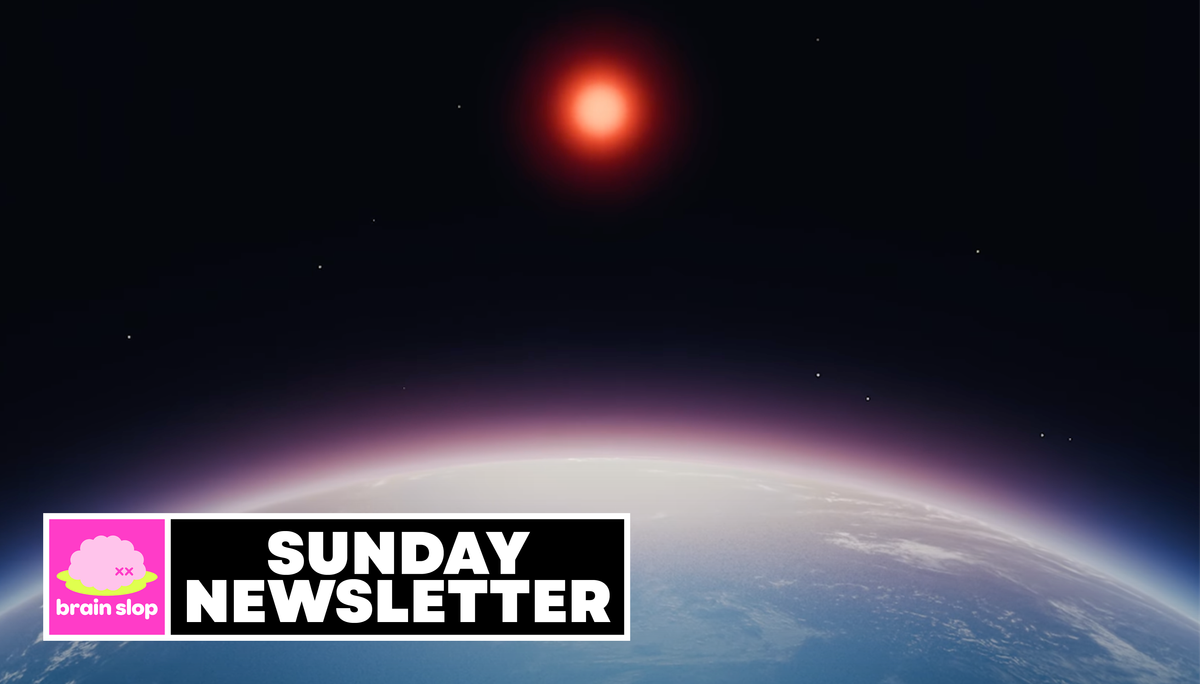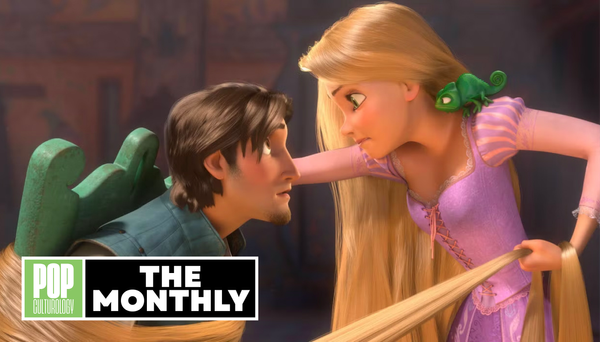K2-18b or not to be?
Have astronomers found life on a planet 120 light-years away from Earth? Or do the signs actually point to another inhabitable world?

Slop Army assemble! (My former colleague/friend of The Omnicosm/Cleveland Prost founder Will Cleveland cast his vote for this to become the official name of Brain Slop readers.)
While Brain Slop was on break last week, news broke that astronomers had found possible signs of life on a planet 120 light-years from Earth.
“I’m not screaming, ‘aliens!’” Nikole Lewis, an exoplanetary scientist, told The New York Times. “But I always reserve my right to scream ‘aliens!’”
So what do scientists look for when they’re searching beyond our solar system for signs of life? Radio signals? Interplanetary trash? A massive cylindrical craft?
In the case of the planet known as K2-18b and the researchers at University of Cambridge, the possible proof is in the planet’s atmospheric makeup.
As an exoplanet passes in front of its host star, its atmosphere, if it has one, is illuminated. Its gases change the color of the starlight that reaches the Webb telescope. By analyzing these changing wavelengths, scientists can infer the chemical composition of the atmosphere.
While inspecting K2-18b, Dr. Madhusudhan and his colleagues discovered it had many of the molecules they had predicted a Hycean planet would possess. In 2023, they reported they had also detected faint hints of another molecule, and one of huge potential importance: dimethyl sulfide, which is made of sulfur, carbon, and hydrogen.
On Earth, the only known source of dimethyl sulfide is life.
There’s a long way to go before these potential clues prove that K2-18b is the home to any kind of life.
“It’s not nothing,” Stephen Schmidt, a planetary scientist, told The New York Times. “It’s a hint. But we cannot conclude it’s habitable yet.”
And even if K2-18b is habitable, we’re not talking about sentient creatures that you’d see arguing the merits of creating a Grand Army of the Republic on Coruscant. The presence of dimethyl sulfide, on Earth at least, is the byproduct of “living organisms such as marine algae.”
An announcement as big as this one was unsurprisingly greeted with healthy skepticism. Over at Ars Technica, John Timmer asked the following three questions:
Is the planet what we think it is?
Is the signal real?
Is life the only way to produce that signal?
There’s a good chance that K2-18b isn’t the Hycean wonderland — a sub-Neptune planet “covered with warm oceans of water and wrapped in atmospheres containing hydrogen, methane and other carbon compounds” — that Nikku Madhusudhan and his University of Cambridge team thinks it is.
“[A different research group] suggests that K2-18b is more likely to be a magma-ocean or gas-dwarf world. And a modeling paper suggests that most potential hycean worlds would suffer from a runaway greenhouse effect unless they receive significantly less illumination than Earth does,” Timmer writes. “Then there’s a draft paper from Glein and his collaborators, which suggests you can get many of the same properties seen in K2-18b from a planet with a deep atmosphere sitting above a magma ocean.”
Yikes.
While astronomers, scientists and the rest of us debate the secrets that K2-18b and other sub-Neptune planets hold, it’s hard to not marvel at the fact that we’re doing this from across space thanks to a telescope that can see almost back to the Big Bang itself.
It’s wild that humans have crafted something with that power. And it’s inspiring that despite the silence of space, we keep trying to find life.
- 📖 Astronomers Detect a Possible Signature of Life on a Distant Planet (Carl Zimmer, The New York Times)
🍿 🍪 Wanna add Popculturology or Snackology to your subscription? Update your email preferences on your account page.

the links
tech
- YouTube is everything and everything is YouTube (David Pierce, The Verge): “Over and over, I heard the same thing: YouTube is more complicated and more diffuse than ever, and it’s definitely no longer a singular platform. But the idea at the core of the thing hasn’t changed at all.”
- How to Survive the A.I. Revolution (John Cassidy, The New Yorker): “The economists acknowledged that a ‘bigger pie does not automatically mean everyone benefits evenly, or at all,’ and cited studies on A.I.’s automation potential. Still, drawing lessons from previous technological transformations, they suggested that displaced workers would eventually find new employment: ‘Job destruction has always been offset by job creation.’ Recently, however, some prominent economists have offered darker perspectives.”
- I got my Switch 2 preorder the old-fashioned way: lining up at GameStop (Ash Parrish, The Verge): “
gambling
- How a Secretive Gambler Called ‘The Joker’ Took Down the Texas Lottery (Joe Wallace and Katherine Sayre, The Wall Street Journal): “The printing operation ran day and night. The team had converted each number combination into a QR code. Crew members scanned the codes into the terminals using their phones, then scrambled to organize all the tickets in boxes such that they could easily locate the winning numbers. The game called for picking six numbers from 1 to 54. For a pro gambler, some sets of numbers — such as 1, 2, 3, 4, 5, 6 — aren’t worth picking because so many other players choose them, which would split the pot. Marantelli’s operation bought 99.3% of the possibilities.”
life
- The ‘Panic Industry’ Boom (Coralie Kraft; Photographs and Video by Richard Barnes, The New York Times Magazine): “Meanwhile, the very rich continue to spend on extreme new forms of protection. In an undisclosed location in the Upper Midwest, one family is building a compound surrounded by a moat that can be lit on fire.”
- The Absolutely, Positively Correct Way to Load Your Dishwasher (Ellen Cushing, The Atlantic): “As soon as I started trying, one sentence began to haunt me. People repeated it to me; it showed up over and over when I searched online for information about dishwashers and dishwasher conflict. It was this: ‘In every relationship, there’s one person who loads the dishwasher like a Scandinavian architect, and one who loads it like a raccoon on meth.’”
nature
- It Took a Century to Find This Colossal Squid (Elizabeth Preston, The New York Times): “She’ll continue looking for a full-grown animal. ‘I can’t wait to see what a live adult colossal squid looks like, at home in the deep sea where it belongs,’ she said. But she said she was also glad that the first sighting of the species in the wild was not of the adult version — an enormous, hook-wielding leviathan, but ‘this beautiful early life stage that looks like a little glass sculpture.’”
- De-Extinction Rebellion (Leo Kim, The Baffler): “Because of how radically opposed these extinction and de-extinction technologies appear on the surface, they’re rarely spoken about in the same breath; yet it’s important to recognize them as two sides of the same coin. Western civilization’s relationship with the environment can be seen as a long history of trying to harness and instrumentalize natural processes in order to bend the world to our convenience.”
- A crow’s math skills include geometry (Nell Greenfieldboyce, NPR): “What the researchers wanted to know is whether or not ‘with these quadrilaterals, they could still continue to find the outlier, even though the outlier was looking perceptually very similar to the other five regular shapes,’ explains Nieder. Yes. It turns out, the crows could.”
- Man Pleads Guilty to Selling Sperm Whale Teeth and Bones (Johnny Diaz, The New York Times): “It was not immediately clear on Sunday how Mr. DeLoach had obtained the items and who then bought them from him. The teeth and the bones are prized for decorations or use in artwork, such as engravings and carvings, prosecutors said.”
science
- This Impossible New Color Is So Rare That Only Five People Have Seen It (Jacek Krywko, Scientific America): ““The name comes from The Wizard of Oz, where there’s a journey to the Emerald City, where things look the most dazzling green you’ve ever seen,” Ng explains. On their own expedition, the researchers used lasers to precisely deliver tiny doses of light to select cone cells in the human eye. First, they mapped a portion of the retina to identify each cone cell as either an S, M or L cone. Then, using the laser, they delivered light only to M cone cells.”
- The ‘Profound’ Experience Of Seeing A New Color (Ross Andersen, The Atlantic): “To see olo, you need to scootch up to the table, chomp down on a bite plate, and keep your head as steady as you can. A laser will be fired into one of your eyes, targeting more than a thousand of your cone cells.”
food
- A Scientist Is Paid to Study Maple Syrup. He’s Also Paid to Promote It. (Will Evans, Ellen Gabler and Anjali Tsui, The New York Times): “One of Dr. Seeram’s studies involved giving maple syrup extract to genetically modified worms to examine Alzheimer’s-related effects. His team observed that some worms fared better, but on average they were worse off. Nevertheless, the top-line summary in Dr. Seeram’s paper, published in 2016 by the journal Neurochemical Research, ignored the negative results and said the syrup extract ‘showed protective effects’ for the worms.”
a cartoon
Copyediting by Tim Kuchman.
💰 Like what you’re reading on Brain Slop? Send a one-time tip to show your support for the newsletter.
➕ Already a brain slop subscriber? Please consider becoming a supporter by upgrading your account.
🍿 🍪 Wanna add Popculturology Snackology to your subscription? Update your email preferences on your account page.
You can also follow me on Bluesky and Instagram.






